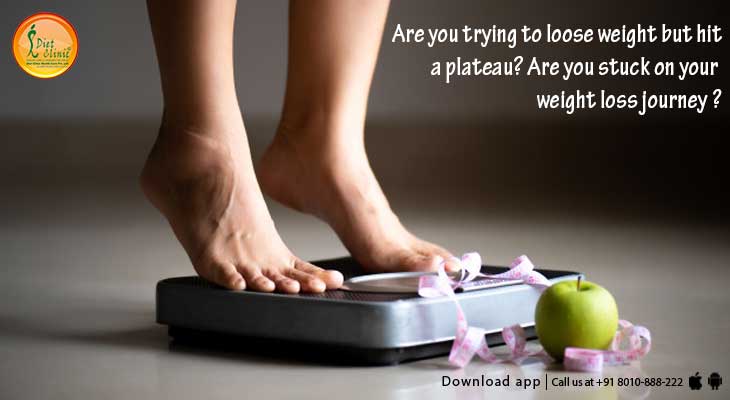
Dietician Sheela Seharawat
Are you trying to lose weight but hit a plateau? Are you stuck on your weight loss journey?
You've been working hard to follow a healthy, low-calorie diet and improve your exercise habits, and your reward has been watching your weight go down and feeling better? Despite so many efforts, your weighing scale is not moving? Frustrated huh!
Don’t worry, its a weight loss plateau.
Don't get discouraged. It's normal for weight loss to slow and even stall. By understanding what causes a weight-loss plateau, you can decide how to respond and avoid backsliding on your new healthy habits.
How can you overcome a weight-loss plateau?
When you reach a plateau, you may have lost all of the weight you will on your current diet and exercise plan. Ask yourself if you're satisfied with your current weight or if you want to lose more, in which case you'll need to adjust your weight-loss program.
If you're committed to losing more weight, try these tips for getting past the plateau:
Drop Your Calorie Intake:
1. To cut down fat, a calorie deficit diet is needed. Consume fewer calories than you burn per day.
2. Instead, keep a food journal for three to four days and track exactly how many calories you’re eating and drinking. Then, gently reduce your calorie intake by 500 calories per day to boost up the fat loss. The fat percentage can be measured either by using calipers or with the BCA machine.
Rotate your workout routine:
Just addicted to the treadmill and cross trainer for the past four months? It’s time to change up your workouts now.
The muscles become familiar with the same old workout, making your regular routine less effective. To see a change in body fat, you have to get outside of your fitness comfort zone. Induce High-Intensity Interval Training (HIIT) to burn body fat effectively. Try a total-body circuit with squats, rows, push presses, and pushups, and do them each for 30 seconds and rest for 30 more seconds before moving to the next exercise. Instead of a basic sprint interval, you’ll hammer your entire body, further boosting your metabolism. As a finisher, use an Airdyne bike, stationary rowing machine, weighted sled, etc. and do max-effort intervals, 15 seconds on, 15 seconds off.
Note: Just progress slowly and deliberately when incorporating high-intensity exercise into your routine. Doing too much too fast can leave you too sore, tired or even injured.
Eat More Protein:
Protein is essential to fat loss, as it maintains your muscle during a calorie deficit. It keeps you satiated, which prevents overeating and snacking on junk food. Also, it boosts your calorie burn throughout the day because takes more energy to digest compared to carbs or fat.
Eat at least one gram of protein per pound of body weight every day and get your protein from whole sources like nuts, eggs, lean meats, yogurts, and quality protein powders.
Eat More Healthy Fats:
To lose more fat, eat more fat. This seems counterintuitive, but healthy fats like animal fats, real butter, coconut oil, nuts, and avocados actually make you leaner and more muscular—they keep you full and maintain your good testosterone levels. If you followed the other rules, eating healthy fats forces you to lower your carbohydrate intake. Get at least 30 percent of your calories from good sources of fat and never consume artificial fats, which can cause health problems like heart disease.
Stay hydrated:
Keep your hydration in check since the body will often crave food when you are even mildly dehydrated. Symptoms of dehydration are similar to symptoms of hunger, so it’s easy to confuse the two. Aim to drink 2-3L of water per day plus additional fluids lost during activity.
Try Intermittent Fasting:
Intermittent fasting increases fat oxidation, which promotes more fat loss. Also, fasting along with exercise boosts insulin sensitivity, helping your body send nutrients to muscle rather than fat. Better still, fasting during a calorie-restricted diet led to more weight loss, than without it. Start simple: skip breakfast for the next few days and eat your first healthy meal of the day in the afternoon.
Get plenty of sleep:
Insufficient sleep can interfere with weight loss by reducing your metabolic rate and shifting your hormone levels to promote hunger and fat storage. Hence, have at least 7-8hrs of good quality sleep.
Eat vegetables at every meal:
Vegetables are loaded with important nutrients, yet low in calories and carbs. Including them at every meal may help you reverse a weight loss plateau.
Don’t rely on the weighing scale alone:
Your scale weight may not reflect a loss of body fat, especially if you work out or experience fluid retention. Evaluate how you feel, how your clothes fit and whether your measurements have changed instead.
Check for any medical condition:
If weight loss has stuck despite all efforts with a changed diet as well as a workout routine, then we need to check if any medical condition is there. Check if thyroid levels are high, any hormonal imbalance, pcod, any vitamin deficiency such as Vit D or B12, we need to correct it first to move the weight further.
Also, check if you are too stressed up as it raises the level of cortisol in the body which inhibits weight loss.
Stay motivated and don’t get demoralized. Weight loss plateau is a part of the weight loss journey and you can definitely beat it.

.png)
.png)






